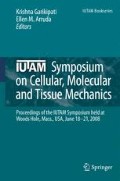Abstract
Adult newts possess the ability to completely regenerate organs and appendages. Immediately after limb loss, the extracellular matrix (ECM) undergoes dramatic changes that may provide mechanical and biochemical cues to guide the formation of the blastema, which is comprised of uncommitted stem-like cells that proliferate to replace the lost structure. Skeletal muscle is a known reservoir for blastema cells but the mechanism by which it contributes progenitor cells is still unclear. To create physiologically relevant culture conditions for the testing of primary newt muscle cells in vitro, the spatio-temporal distribution of ECM components and the mechanical properties of newt muscle were analyzed. Tenascin-C and hyaluronic acid (HA) were found to be dramatically upregulated in the amputated limb and were co-expressed around regenerating skeletal muscle. The transverse stiffness of muscle measured in situ was used as a guide to generate silicone-based substrates of physiological stiffness. Culturing newt muscle cells under different conditions revealed that the cells are sensitive to both matrix coating and substrate stiffness: Myoblasts on HA-coated soft substrates display a rounded morphology and become more elongated as the stiffness of the substrate increases. Coating of soft substrates with matrigel or fibronectin enhanced cell spreading and eventual cell fusion.
Access this chapter
Tax calculation will be finalised at checkout
Purchases are for personal use only
References
Namenwirth M (1974) The inheritance of cell differentiation during limb regeneration in the axolotl. Dev Biol 41:42–56
Sanes JR (2003) The basement membrane/basal lamina of skeletal muscle. J Biol Chem 278:12601–12604
Kuang S, Kuroda K, Le Grand F, Rudnicki MA (2007) Asymmetric self-renewal and commitment of satellite stem cells in muscle. Cell 129:999–1010
Gulati AK, Reddi AH, Zalewski AA (1983) Changes in basement membrane zone components during skeletal muscle fiber degeneration and regeneration. J Cell Biol 97:957–962
Morrison JI, Loof S, He P, Simon A (2006) Salamander limb regeneration involves the activation of a multipotent skeletal muscle satellite cell population. J Cell Biol 172:433–440
Cameron JA, Hilgers AR, Hinterberger TJ (1986) Evidence that reserve cells are a source of regenerated adult newt muscle in vitro. Nature 321:607–610
Hay ED (1959) Electron microscopic observations of muscle dedifferentiation in regenerating Amblystoma limbs. Dev Biol 1:555–585
Lo DC, Allen F, Brockes JP (1993) Reversal of muscle differentiation during urodele limb regeneration. Proc Natl Acad Sci 90:7230–7234
Echeverri K, Clarke JDW, Tanaka EM (2001) In vivo imaging indicates muscle fiber dedifferentiation is a major contributor to the regenerating tail blastema. Dev Biol 236:151–164
Kumar A, Velloso CP, Imokawa Y, Brockes JP (2004) The regenerative plasticity of isolated urodele myofibers and its dependence on MSX1. PLoS Biol 2:1168–1176
Smith GN, Toole BP, Gross J (1975) Hyaluronidase activity and glycosaminoglycan synthesis in the amputated newt limb: Comparison of denervated, nonregenerating limbs with regenerates. Dev Biol 43:221–232
Gulati AK, Zalewski AA, Reddi AH (1983) An immunofluorescent study of the distribution of fibronectin and laminin during limb regeneration in the adult newt. Dev Biol 96:355–365
Onda H, Goldhamer DJ, Tassava RA (1990) An extracellular matrix molecule of newt and axolotl regenerating limb blastemas and embryonic limb buds: Immunological relationship of MT1 antigen with tenascin. Development 108:657–668
Epperlein HH, Halfter W, Tucker RP (1988) The distribution of fibronectin and tenascin along migratory pathways of the neural crest in the trunk of amphibian embryos. Development 103:743–756
Boudreau N, Turley E, Rabinovitch M (1991) Fibronectin, hyaluronan, and a hyaluronan binding protein contribute to increased ductus arteriosus smooth muscle cell migration. Dev Biol 143:235–247
Li Y, Toole BP, Dealy CN, Kosher RA (2007) Hyaluronan in limb morphogenesis. Dev Biol 305:411–420
Mailman ML, Dresden MH (1976) Collagen metabolism in the regenerating forelimb of Notophthalmus viridescens: Synthesis, accumulation, and maturation. Dev Biol 50:378–394
Kujawa MJ, Pechak DG, Fiszman MY, Caplan AI (1986) Hyaluronic acid bonded to cell culture surfaces inhibits the program of myogenesis. Dev Biol 113:10–16
Macfelda K, Kapeller B, Wilbacher I, Losert UM (2007) Behavior of cardiomyocytes and skeletal muscle cells on different extracellular matrix components-relevance for cardiac tissue engineering. Artif Organs 31:4–12
Tremble P, Chiquet-Ehrismann R, Werb Z (1994). The extracellular matrix ligands fibronectin and tenascin collaborate in regulating collagenase gene expression in fibroblasts. Mol Biol Cell 5:439–453
Fraser JRE, Laurent TC, Laurent UBG (1997) Hyaluronan: Its nature, distribution, functions and turnover. J Intern Med 242:27–33
Jones FS, Jones PL (2000) The tenascin family of ECM glycoproteins: Structure, function and regulation during embryonic development and tissue remodeling. Dev Dyna 218:235–259
Engler AJ, Griffin MA, Sen S, Bonnemann CG, Sweeney HL, Discher DE (2004) Myotubes differentiate optimally on substrates with tissue-like stiffness: Pathological implications for soft or stiff microenvironments. J Cell Biol 166:877–887
Engler AJ, Sen S, Sweeney HL, Discher DE (2006) Matrix elasticity directs stem cell lineage specification. Cell 126:677–689
Ripellino JA, Klinger MM, Margolis RU, Margolis RK (1985) The hyaluronic acid binding region as a specific probe for the localization of hyaluronic acid in tissue sections. Application to chick embryo and rat brain. J Histochem Cytochem 33:1060–1066
Shull KR (2002) Contact mechanics and the adhesion of soft solids. Mat Sci Eng R 36:1–45
Acknowledgments
The authors would like to thank Prof. Ken Shull and Katie Otim, of the Department of Materials Science and Engineering at Northwestern University, for assistance with mechanical testing. This research was funded by the NIH, DARPA and the Searle Foundation.
Author information
Authors and Affiliations
Corresponding author
Editor information
Editors and Affiliations
Rights and permissions
Copyright information
© 2010 Springer Science+Business Media B.V.
About this paper
Cite this paper
Calve, S., Simon, HG. (2010). Extracellular Control of Limb Regeneration. In: Garikipati, K., Arruda, E. (eds) IUTAM Symposium on Cellular, Molecular and Tissue Mechanics. IUTAM Bookseries, vol 16. Springer, Dordrecht. https://doi.org/10.1007/978-90-481-3348-2_22
Download citation
DOI: https://doi.org/10.1007/978-90-481-3348-2_22
Published:
Publisher Name: Springer, Dordrecht
Print ISBN: 978-90-481-3347-5
Online ISBN: 978-90-481-3348-2
eBook Packages: Chemistry and Materials ScienceChemistry and Material Science (R0)

